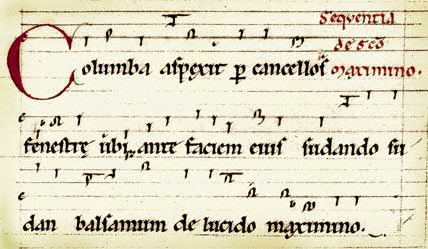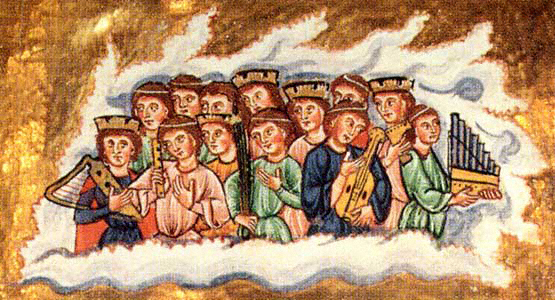

Columba aspexit was written during the Medieval Period, and was composed by Hildegard of Bingen (1098-1179), abbess of a convent in Rupertsberg, Germany (near Bingen). In addition to being a church leader, Hildegard also was a theologian, visionary, composer, and writer. Hildegard's religious writings were recognized and approved by religious authorities such as Pope Eugenius II and Saint Bernard of Clairvaux. As a result, throughout her life, many sought her counsel such as popes, emperors, religious leaders and laypeople.[8] It is interesting to note that women during the Medieval period had few rights or privileges, and other than a few notable exceptions (e.g. women of nobility such as Eleanor of Aquitaine or women with religious ties such as Hildegard), women did not generally occupy positions of power or influence.
Hildegard was a prolific composer, and wrote music to fill religious needs in her convent such as music for Offices, Masses and special services. Hildegard wrote Columba aspexit's text and music for a special church service: a Mass honoring Saint Maximus. This piece was written in plainchant: a single melody sung by a soloist or choir. Hildegard's melody features syllabic, neumatic and melismatic passages. These terms are used to indicate that instead of each syllable of the text being sung to a single note (syllabic), some syllables call for several notes (neumatic) or many notes per syllable (melismatic). Hildegard used this technique and a soaring melody with a wide range to highlight and emphasize the descriptive imagery of her poetic text.
As illustrated in Fig. 1.5, an image of Hildegard’s Columba Aspexit manuscript, during the Medieval period, rhythm was not notated. Musically, this is described as "free rhythm" or "unmeasured rhythm" meaning, the rhythm is set by the performer. It should be noted that there is scholarly debate regarding how to interpret rhythm when performing plainchant. Some musicians use approximately equal note values for each note, with no discernable beat or metric accent. The musical form used in this piece is called a sequence: a chant of the Mass sung between sections called the Alleluia and the Gospel. In this form, each melodic phrase is generally sung twice, with a slight variation the second time: AA'BB'CC'. Although Hildegard's Columba aspexit manuscript is notated only for voice, she apparently approved of the use of instruments with her music. She wrote in one of her books of visions: "We are to praise God with the trumpet, harp, zither, organ, drum, strings, flute, cymbals, dance." [9] Stringed instruments played during the Medieval period included rebecs and Medieval fiddles, and a fiddle is shown in the image below from one of Hildegard's books of visions.

TECHNIQUE TIPS: During Hildegard's time, if a stringed instrument such as a rebec or medieval fiddle were to play along with the vocal part of Columba aspexit, the instrumental part would likely have been a drone: one sustained note throughout the entire piece (an open D in this arrangement). To try this, place your bow at the frog and begin with a down-bow, playing long, smooth bow strokes on your open D as the melody line is played or sung. When you change bows, do so as smoothly as possible so your note will sound sustained and unbroken throughout the piece. While playing, you may want to watch your bow to make sure you're able to draw it in a straight line, parallel between the bridge and the fingerboard.
Although Hildegard's Columba Aspexit melody was intended for singers, it has been included in this collection of pieces to provide an example of music from this era. Hildegard's melody features a lovely soaring melodic line that floats up and down, mirroring the expressive text with phrases that seem to call for slight pauses. Experiment with slurs and bow changes to see how you can create a smooth, flowing melody and decide when and where you feel the need to slightly pause your bow to indicate when you have reached the end of a musical phrase.
© Copyright 2025 RK Deverich. All rights reserved.
Although this online bass class is provided free of charge, all rights are reserved and this content is protected by international copyright law. It is illegal to copy, post or publish this content in any form, and displaying any of this material on other websites, blogs or feeds is prohibited. Permission is given for individual users to print pages and perform music from this website for their personal, noncommercial use.